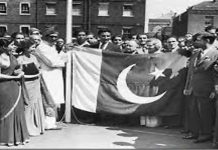Peshawar: In September, India and Pakistan seemed on the brink of a war with clashes on the border, India claiming surgical strikes and Pakistan taking evidence of Indian oppression in Kashmir to the UN General Assembly.
Yet a group of Pakistani youth were in India to make peace.
“Youth are fed up with the old and constructed narratives of hatred [existing in the two countries],” said Alia Harir, head of the Aghazdosti programme, a youth-led Indo-Pak friendship initiative. “The narratives of war and hate can be replaced by narratives of peace and harmony among the two nuclear-armed nations.”
Harir, one of 19 women and 1 man in the group visiting India, said youth campaigns and people-to-people initiatives had reinforced her belief that the young people wished to go beyond popular narratives, beyond the sentiment of war, and make their voices for peace heard.
Since the Partition of British India in 1947 that led to the creation of Pakistan and India, the two South Asian countries have gone to war four times – 3 active and one undeclared in 1999. The history of their mutual ties is complicated by frequent border skirmishes and military stand-offs, with Kashmir, a disputed Himalayan state, a main irritant to peaceful relations.
Post 9/11, the military standoffs between the two countries have taken on an alarming frequency, raising the specter of nuclear war in the region. India and Pakistan have come close to war on at least three occasions – in 2002 after militants attacked the Indian Parliament on 13 December, 2001; in 2008 after the Mumbai attacks and now in September, after militants attacked Indian army at Uri in Indian Administered Kashmir. India has blamed Pakistan for these attacks.
Ram Subramanian, an Indian peace campaigner, is of the view that the youth of Pakistan and India that are out to push for peace today would be leaders in their respective countries tomorrow. He said he didn’t believe in “media injected narratives” in both the countries.
Speaking of the saber-rattling in the wake of Uri attacks that created mutual paranoia and mistrust, he told News Lens Pakistan: “I don’t want others to tell me who to love and who to hate. These are colored views.”
Like the Aghazdosti initiative, Track II diplomacy or people to people contacts – allowing non-governmental, informal, unofficial contacts and activities between private citizens or groups of individuals, as opposed to Track I which involved governments and officials – has been an active conflict-resolution framework followed by pro-peace individuals and groups in the protracted and complex Indo-Pak context.
According to Track-Two Diplomacy between India and Pakistan: A Study in Diplomatic Overture, the first prominent Track Two initiative between India and Pakistan was the Neemaran dialogue that took place under the auspices of the United States Information Services (USIS) in 1990 and was later joined by American foundations and German nongovernmental organizations (NGOs). Its first meeting was held in Neemrana Fort in Rajhasthan, India in October 1991. The group was comprised of former diplomats, former military personnel, media persons, NGO workers and academics from India and Pakistan.
Since then, there has been a significant increase in the number of Track Two initiatives between India and Pakistan, says the study. “Of late, some new such initiatives have started, such as the Chaophraya Dialogue, the WISCOMP annual workshop, the Pugwash Conferences, Ottawa Dialogue, and so on. There exist more than twelve highly institutionalised Track Two groups, as well as over twenty other people-to-people exchange programmes operating between the two nuclear powers, with both external and internal funding.”
Three conflict resolution frameworks are actively creating effective relationship between India and Pakistan, says Khadim Hussain, a political analyst based in Peshawar. “These are people to people contact, diplomatic contacts and political contacts. In case of Pakistan and India, there is a dire need to involve marginalized groups in these three frameworks [youth, women, academia and artisans].”
The bitter relations between the two countries have affected people from all walks of life, said Gurmeher, 20, who lost her father in border clashes during the undeclared Kargil war in 1999.
“Youth campaigns are the way to go because 10 years down the line, ours will be the generation dictating the course of things,” said Gurmeher, who is now an active peace campaigner in India. “We will be adults. This is the age we form opinions and act on them.”
Gurmeher sees youth as dynamic, ambitious and global: “It is this that sets us [youth] apart from our ancestors.”
Ediola Pashollari, the Secretary General of World Assembly of Youth, is a strong proponent of Track II diplomacy involving youth because “we cannot change neighbors, and the only way to restore good relations is to use people-to-people contact and youth to pressure their states to go for dialogue.”
The census 2011 data shows that around 41 percent of India’s population is below the age of 20. According to the Times of India, half the population is in the 20-59 age group while 9 percent is above the age of 60.
The Pakistan Institute of Development Economics’ population estimates for the year 2009 show that there are about 40.32 million children aged 5-14 years and about 36 million youth population aged 15-24 years who, together, account for about 45 percent of thepopulation.
According to Chanchal Manohar Singh, Chairman Society for Promotion of Peace in South Asia, youth has greater exposure given their use of technology and social media. “They are important part of the peace diplomacy among the two neighboring states.”
Asma Jehangir, a leading human rights activist, says Pakistan should lift the ban from student unions and participation of youth in political process to make Track II diplomacy more fruitful.
“Both countries should realize that youth involvement is necessary because they have sharp ideas and they can think out of the box to bring about sustainable peace,” says Jehangir.



